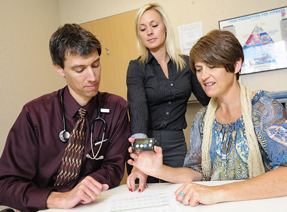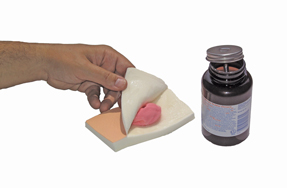Monitoring glucose minute by minute
Continuous glucose monitoring presents challenges not only to patients, but to internists learning how best to teach their patients how to use them. But with a lack of enough endocrinologists to care for the 1 million patients with type 1 diabetes, internists have to pick up the slack.
Despite recent studies bolstering the case for continuous glucose monitoring in type 1 diabetes, the technology's use remains limited, in part due to the complex nuances involved for time-pressed physicians and patients alike.
Even for a highly motivated patient, glucose sensors—whether tied to an insulin pump or not—deliver a barrage of readings that can take time to comprehend and address, according to physicians who prescribe the technology. To facilitate success, physicians ideally should create a supportive network of education and other resources, including potentially expanding staff to handle issues ranging from worried patient phone calls to insurance coverage headaches. The sensors, worn just under the skin's surface, either can be used in conjunction with a pump, or with multiple daily injections to more closely track and stabilize glucose levels.

It's a tall order for many endocrinologists, never mind an internist in private practice, said Howard Wolpert, MD, director of the insulin pump and continuous glucose monitoring programs at the Joslin Diabetes Center in Boston. “Patients do need a lot of careful close guidance when they get started on the technology, so they learn how to use it effectively,” he said.
But recent research findings and the ongoing evolution in the devices themselves will force more internists to get up to speed, said Satish Garg, MD, director of the adult clinic at the University of Colorado Denver's Barbara Davis Center for Childhood Diabetes. If nothing else, there simply aren't enough endocrinologists to care for the estimated 1 million adults living with type 1 diabetes, he said. “They [internists] don't have a choice—they have to get on board.”
According to findings published online by the New England Journal of Medicine in June, an insulin pump used in conjunction with continuous glucose monitoring is more effective in helping people with type 1 diabetes achieve target glucose levels than the more traditional method of multiple daily injections paired with blood glucose checks. The study, which enrolled a total of 485 adults and children, also didn't find any significant difference in severe hypoglycemia rates between the two groups. The research was led by members of the Sensor-Augmented Pump Therapy for A1C Reduction (STAR 3) Study Group.
The results show that physicians should consider the pump-sensor combination for patients who can't adequately control their glucose with daily injections, said Richard Bergenstal, MD, lead author of the study and executive director of the International Diabetes Center at Park Nicollet in Minneapolis.
Assessing methods
In the STAR 3 study, the mean A1C level, 8.3% at baseline in both groups, had declined after one year to 7.5% in patients using pumps plus sensors compared with 8.1% in patients using multiple daily injections. More patients using the pump reached the A1C goal of less than 7% when compared with the multiple daily injection cohort. Plus, there was no difference in the rate of severe hypoglycemia among the patients: slightly more than 13 cases per 100 person-years in both groups.
The STAR 3 study also identified significant benefits specifically in children. In a post hoc analysis, researchers found that a total of 44% of children or adolescents in the pump and sensor group achieved A1C targets recommended by the American Diabetes Association (ADA). Among those using multiple daily injections, 20% reached those goals.
The sensor-augmented insulin pump used in the study, sponsored by Medtronic, is one of the latest steps in manufacturers' ongoing effort to develop an automated closed-loop system, in which insulin levels could be adjusted automatically. No such system has been approved for use in the United States. Last year, Medtronic introduced a device in Europe that automatically suspends insulin delivery when an individual's blood glucose drops dangerously low.
Dr. Wolpert described the STAR 3 results as encouraging, but added a few cautionary notes, including the level of patient support provided in a research setting. “It's a very different reality in terms of the amount of time and attention one can give patients in a clinical trial relative to a clinical practice,” he said.
It's also difficult to sift out how much of the glucose control can be attributed to the sensor versus the initiation of the pump itself, since there was no pump-only group of patients in STAR 3, Dr. Wolpert said, echoing a point he made in an editorial he wrote accompanying the NEJM study.
The optimal study approach would have been to include all four current glucose control techniques, Dr. Bergenstal said: the pump alone, the pump with a glucose sensor, multiple daily injections with a sensor and the traditional injection/glucose meter approach. But that route was precluded by the cost and the number of participants that would have been required, he said. Instead, researchers compared the newest technologies to optimizing the most common approach used to treat type 1 diabetes.
Meanwhile, few available data assess a sensor's effectiveness in conjunction with multiple daily injections versus an insulin pump. Dr. Bergenstal and other experts couldn't point to any head-to-head studies, other than an analysis presented at this summer's ADA meeting.
That study, which followed 34 adults for six months, found no difference in glucose control between the two groups, which were using sensors either with an insulin pump or multiple daily injections. Both groups achieved a statistically significant improvement in A1C at the 12th week, but it was not sustained over the course of the study, said Dr. Garg, the study's lead author. That finding has clinical implications, he said: “You need to keep reinforcing the [sensor's] use.”
Technology in practice
Dr. Garg's study also highlighted the difficulties involved in convincing patients to stick with the sensors, Dr. Wolpert pointed out. Sixty patients were enrolled in the study. For their results to be included in the analysis, though, they had to be using the sensors at least six days a week. Only 34 patients met that criterion.
But that compliance rate, Dr. Garg said, was higher than he had anticipated. In his own practice, he estimates that no more than one in every five patients uses the sensor that frequently, due to the cost and other logistics. But even using a sensor every six weeks delivers vastly more detail on glucose patterns, nearly 3,000 blood glucose readings for devices that work as long as 10 days. (Sensors vary in terms of how long they can be used and how frequently they check glucose levels.) In comparison, just four seconds of information is typically obtained via blood glucose checks, he said.
Forced to choose—pump versus sensor—Dr. Garg would opt for the latter device. “Since we cannot afford to put everybody on the pumps, if people are on multiple daily injections, they can get a much better return from being on the sensor versus being on the pump by itself,” he said. “However, when closed-loop is available, use of combination devices would be the best choice.”
Irl B. Hirsch, FACP, professor of medicine at the University of Washington School of Medicine in Seattle, seconded that opinion. “It's a no brainer—it's the sensor,” he said. “It's not even close.”
But prescribing a glucose sensor can lead to numerous insurance hurdles that involve staff time as well as the physician's, Dr. Hirsch said. Some insurance providers will maintain that the device is still experimental or that the patient hasn't demonstrated sufficient problems with hypoglycemia, he said. More research data helps, but even so sometimes both Dr. Hirsch and the patient have to appeal the initial coverage decision.
Insurance companies are more likely to cover the sensor if it's being used with a pump, rather than with injections, said Yogish C. Kudva, ACP Member, a consultant in the division of endocrinology at Mayo Clinic in Rochester, Minn.
Convincing insurance providers to cover the sensor without a pump is harder, Dr. Hirsch agreed, in large part because most published data involve the sensor-pump combination. But doctors can make a case by citing data like Dr. Garg's head-to-head analysis, as well as patient successes in their own practice, he said.
Once patients do begin using the sensor, one challenge is managing expectations and anxieties, Dr. Wolpert said. “When people start on the technology and they are getting frequent glucose measurements, some patients actually feel like they are doing worse.” For example, they are seeing insulin spikes after eating that they might not necessarily have been aware of previously. “One has to forewarn them about this, so people don't take that as a sign of failure that they are doing worse,” he said.
Dr. Wolpert was involved with a study, first presented at this summer's ADA meeting, that looked at the types of patients who achieved more sensor success. The research, which has been published online in Diabetic Medicine, was based on interviews with 20 adults with type 1 diabetes. Those who achieved the best results were more likely to have spousal or other support, as well as to have demonstrated a problem-solving sensibility.
“The people who responded in an emotion-based way, they get anxious and frustrated, tended to do less well than people who were more stoic,” Dr. Wolpert said.
Justen Rudolph, ACP Member, an internist in Billings, Mont. who specializes in diabetes, has similarly discovered that his best sensor patients are not only able to adjust their own insulin, but are willing to work with and adapt to the technology. “And certainly the people who do best,” he said, “are the classic ‘type As'.”
Phasing education
Starting a patient on a sensor requires intensive and ongoing education. Dr. Hirsch described a multi-stage education process that his type 1 patients complete, beginning with a group class of an hour or longer, outlining the differences between different sensors. That class is followed by more instruction on the sensor itself, if the patient decides to try the device. Once patients acquire the device, a follow-up visit is scheduled within the first few weeks to help further explain and analyze the glucose data being generated.
To introduce patients to continuous glucose monitoring, the STAR 3 study also adopted a phased-in strategy. Patients in the study began using the pumps first, followed by the introduction of the sensors two weeks later. Dr. Rudolph waits even longer, delaying sensor introduction for one to six months after the insulin pump.
Once his patients get a sensor, he asks them to look at the incoming data for a month without taking any action. Dr. Rudolph, who has type 1 diabetes himself, learned this lesson firsthand when he added a sensor to his insulin pump several years ago. Despite his medical training, he said, it was difficult not to overreact to the flood of incoming data.
Another challenge, as patients adjust to the technology, is avoiding alarm burnout. The alarms can sound not only for hypoglycemia and hyperglycemia, but also in other situations, such as a reminder to calibrate the device. Dr. Wolpert recounted situations in which the alarm sounds so frequently that spouses will choose to sleep in separate beds. To limit those stresses, he typically sets both the hypoglycemia and hyperglycemia thresholds wide, except in some situations, such as when severe hypoglycemia is the primary concern, in which he sets that end tighter.
Over time, the thresholds are adjusted as the patient becomes more comfortable with the sensors. Dr. Wolpert added that there isn't any standard threshold defined, so it's up to the clinician's discretion.
Can busy internists treating patients with numerous other maladies handle this level of close monitoring and related complexities? “It's not that it can't be done,” said Dr. Kudva, adding that interested internists can acquire the necessary training at workshops. “But achieving standards in internists' offices is not going to be easy.”
Dr. Garg, however, argued that internists are already treating people with type 1 diabetes. With training, say a week or two at an academic medical center, they could develop some facility with the sensors, he said. And Dr. Hirsch pointed to the Billings practice where Dr. Rudolph works as one example of the type of high-tech diabetes care that an interested internist can offer.
“This is not rocket science, but it does take time,” Dr. Rudolph said. “You have to have the time and energy to develop a new skill.”
Also, he added, “I think this is the direction that diabetes is going. And I think eventually many patients, if not the majority of patients, will be on a sensor. I think getting started early in this process and learning how to help our patients manage and interpret this information is important.”




